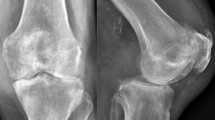Abstract
Total knee replacement (TKR) infection represents only a small percentage of all the potential complications in joint replacement, but one that can lead to disastrous consequences. Two-stage revision, which has been proven to be the most effective technique in eradicating infection, includes prosthesis removal, positioning of an antibiotic-loaded spacer, and systemic antimicrobial therapy for at least 6 weeks. It has been suggested that there is better performance in terms of range of motion, pain, extensor mechanism shortening, and spacer-related bone loss if articulating spacers are used instead of fixed spacers. In this paper, we describe our results in two-stage revision of infected total knee arthroplasty with a minimum follow-up of 12 months on 14 patients treated by antibiotic-loaded custom-made articulating spacer as described by Villanueva et al. (Acta Orthop 77(2):329–332, 2006). The mean flexion achieved after the second stage of the revision was 120°, ranging from 97° to 130°. The mean Hospital for Special Surgery score was 84. At 1 year after surgery, none of the knees showed any evidence of recurrence of the infection. Articulating spacers are a suitable alternative to fixed spacers with good range of motion after reimplantation and effectiveness against total knee replacement deep infections.













Similar content being viewed by others
References
Villanueva M, Rios A, Pereiro J, Chana F, Fahandez-Saddi H (2006) Hand-made articulating spacers for infected total knee arthroplasty: a technical note. Acta Orthop 77 (2):329–332
Patel VP, Walsh M, Sehgal B, Preston C, DeWal H, Di Cesare PE (2007) Factors associated with prolonged wound drainage after primary total hip and knee arthroplasty. J Bone Joint Surg Am 2007 89 (1):33–38
Soohoo NF, Zingmond DS, Lieberman JR, Ko CY (2006) Optimal timeframe for reporting short-term complication rates after total knee arthroplasty. J Arthroplasty 21 (5):705–711
Goldman RT, Scuderi GR, Insall JN (1996) 2-stage reimplantation for infected total knee replacement. Clin Orthop Relat Res (331):118–124
Wilde AH, Ruth JT (1988) Two-stage reimplantation in infected total knee arthroplasty. Clin Orthop Relat Res (236):23–35
Teeny SM (1990) Treatment of infected total knee arthroplasty. Irrigation and debridement versus two-stage reimplantation. J Arthroplasty 5:35–39
Borden LS, Gearen PF (1987) Infected total knee arthroplasty. A protocol for management. J Arthroplasty 2:27–36
Fehring TK et al (2000) Articulating versus static spacers in revision total knee arthroplasty for sepsis. The Ranawat Award. Clin Orthop Relat Res (380):9–16
Emerson RH Jr et al (2002) Comparison of a static with a mobile spacer in total knee infection. Clin Orthop Relat Res (404):132–138
Hofmann AA et al (1995) Treatment of infected total knee arthroplasty using an articulating spacer. Clin Orthop Relat Res (321):45–54
Haddad FS et al (2000) The PROSTALAC functional spacer in two-stage revision for infected knee replacements. Prosthesis of antibiotic-loaded acrylic cement. J Bone Joint Surg Br 82:807–812
Meek RM (2003) Patient satisfaction and functional status after treatment of infection at the site of a total knee arthroplasty with use of the PROSTALAC articulating spacer. J Bone Joint Surg Am 85-A:1888–1892
Dixon P, Parish EN, Cross MJ (2004) Arthroscopic debridement in the treatment of the infected total knee replacement. J Bone Joint Surg Br 86:39–42
Ha CW (2006) A technique for intraoperative construction of antibiotic spacers. Clin Orthop Relat Res 445:204–209
Goldstein WM, Kopplin M, Wall R, Berland K (2001) Temporary articulating methylmethacrylate antibiotic spacer (TAMMAS). A new method of intraoperative manufacturing of a custom articulating spacer. J Bone Joint Surg Am 83-A(Suppl 2 Pt 2):92–97
Windsor RE, Insall JN et al (1990) Two-stage reimplantation for the salvage of total knee arthroplasty complicated by infection. Further follow-up and refinement of indications. J Bone Joint Surg Am 72:272–278
McPherson EJ, Lewonowski K, Dorr LD (1995) Use of an articulated PMMA spacer in the infected TKA. J Arthroplasty 10:87–89
Duncan CP, Beauchamp CP, Masri B et al (1992) The antibiotic loaded joint replacement system: A novel approach to the management of the infected knee replacement. J Bone Joint Surg Br 74-B(Suppl III):296
Booth RE Jr, Lotke PA Jr (1989) The results of spacer block technique in revision of infected total knee arthroplasty. Clin Orthop Relat Res (248):57–60
Calton TF, Fehring TK, Griffin WL (1997) Bone loss associated with the use of spacer blocks in infected TKA. Clin Orthop Relat Res (345):148–154
Author information
Authors and Affiliations
Corresponding author
Rights and permissions
About this article
Cite this article
Pascale, V., Pascale, W. Custom-made Articulating Spacer in Two-stage Revision Total Knee Arthroplasty. An Early Follow-up of 14 Cases of at Least 1 Year After Surgery. HSS Jrnl 3, 159–163 (2007). https://doi.org/10.1007/s11420-007-9048-1
Published:
Issue Date:
DOI: https://doi.org/10.1007/s11420-007-9048-1




